By Jeffrey A. Rendall, Images courtesy of Miura Golf
HEMIJI, JAPAN – Miura Golf has a corporate mantra: Nothing will be introduced unless it improves upon what is already in place. It’s the same for all of Miura’s family of products, but particularly true for its CB-501 irons.
Bill Holowaty, Miura Golf’s Executive Vice President, Product Strategies, explains. “It’s important to realize that any of our products within our line don’t feel the same pressures the golf industry as a whole does in terms of replacing certain things – basically finding a way to sell very similar products in the next cycle.”
Because of that lack of pressure, you might say, the minds behind Miura Golf are rather deliberate in developing new clubs. They’ll sell no clubs before their time, in other words.
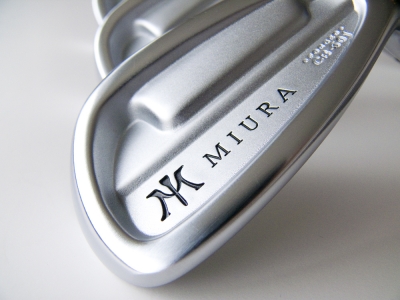 |
It’s been that way since the beginning for the company, founded by Japanese master craftsman Katsuhiro Miura in the late 1950’s. The elder Miura still holds the #1 seat on the grinding line, though Holowaty says it isn’t occupied for as many hours as it used to be.
Carrying on the family tradition are Katsuhiro’s sons, Shinei and Yoshitaka, the latter having a club-finishing skill set similar to his father. Shinei has assumed the role as President of the company (following Japanese tradition, Katsuhiro is now Chairman).
In the case of the CB-501 irons, their development originated after a series of Miura family trips around the world to explore the differing conditions for golf outside of Japan.
“They discovered that it wasn’t the same everywhere,” Holowaty expounded. “The club head’s ability to get through the turf and make good contact became a much more important part of their design work. Combined with launch technology, they’re able to see exactly what a ball is doing in terms of spin, launch angle and speed off the club face.”
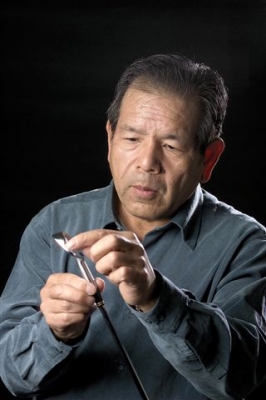 |
| Katsuhiro Miura |
As a result, the Miuras came up with a leading edge and sole design within the CB-501 that promoted all the best things about what golfers are looking for out of their club head.
The CB-501 was the first Miura model to incorporate that bounce/leading edge/sole design, which enabled good club head contact with the ball. In essence, the new design is what differentiated it from previous Miura models like the CB-202, MC-102 or the Tournament Blade.
“People always talk about how beautiful a Miura club head is and how the topline is so good and they’re classic looking,” Holowaty added. “But obviously, the performance of a club head extends beyond what it looks like. The heart of the matter is, the sole design, the leading edge design, the bounce within the club continues to fuel the popularity of the CB-501.”
Like all Miura clubs, the CB-501’s are exceptionally agreeable to the eye. Simply put, Miura club heads are what golf clubs are supposed to look like – pleasing and confidence inspiring. They’re like a work of art, which is essentially what they are.
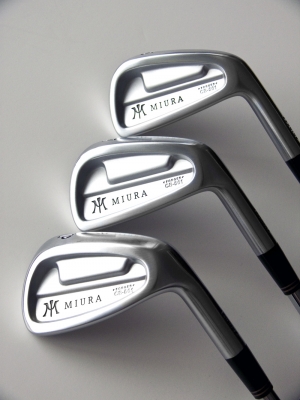 |
The CB-501 contains the new technology Holowaty described, but unlike some Miura models, it also offers a cavity-back as opposed to a muscleback. Is there a difference?
“Mr. Miura has always said there is no difference in philosophy between the different irons models Miura makes,” Holowaty elaborated. “They’re all designed to do the same thing. A CB-501 8-iron is meant to deliver the same excellent performance as an 8-iron in the Tournament Blade.”
“But the difference boils down to what the golfer sees in them. There’s the confidence that a little bit thicker topline might give a player. There’s the confidence there’s a difference in the sole design and leading edge that’s in the CB-501 – as well as offset and the shape of the head. All of those things work to frame the ball for us, so that when we set it down in the address position, we’re confident.”
Holowaty said Miura’s muscleback irons do offer weight in the back of the club head to deliver a certain kind of feel and performance along with perhaps a more penetrating ball flight. In contrast, the cavity back’s weight distribution is more forgiving, producing better results on off-center hits.
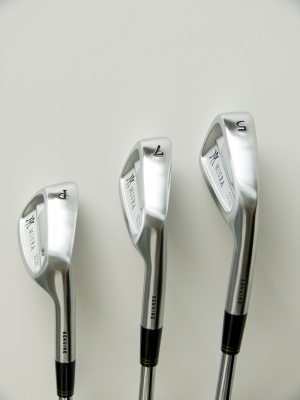 |
Both types of clubs are a result of the special Miura manufacturing process that produces the tightest grain structure in the industry. Miura Golf is able to manipulate the grain structure within a club head, spreading weight throughout to deliver performance even on off-center hits.
There is still a sweet-spot and a center-of-gravity in the club head, of course, but the variances are smaller in Miura products.
“We’ll see cases with not only robot testing but player testing on launch where someone will say ‘I got that one a little bit off the toe’ and yet the results are favorable. The shot may be short and right, but a non-Miura club might yield something that was shorter and righter,” Holowaty said.
Yet another way the Miura company is moving with the times is adjusting its “standard” irons set. My set of CB-501’s is 4-PW, a configuration Holowaty says is becoming the norm.
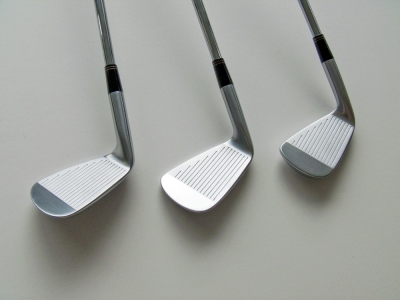 |
“We graduated, probably four to five years ago, to 4-PW being the standard and certainly even 5-PW seems to be what we see as a more popular makeup now. We have hybrids within our product line to take the place of the 3-iron and 4-iron right now.”
Mr. Miura recognized that many golfers from pros to high handicappers find hybrids easier to get in the air and hit to the target. The Miura 3 or 4-hybrid is the same weight as a forged iron in the same number, so they flow nicely into the set of clubs in terms of delivering consistency and performance.
The company still makes 3-irons, of course, and you can customize the set any way you like. Holowaty says you can even order 2 or 1-irons if you desire. A Miura 1-iron would certainly be a collector’s item as well!
Custom fitting is essential with Miura clubs, as it is for all golf clubs in general. The CB-501 was designed to perform for every type of player, but that doesn’t mean every CB-501 set should look the same.
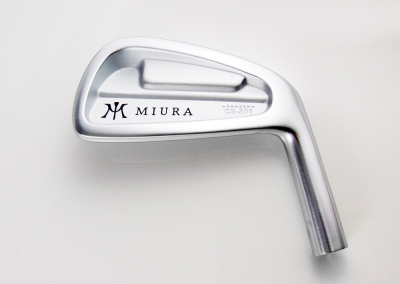 |
Holowaty cites the example of a 78-year old avid golfer to illustrate the benefits of custom fitting: “The gentleman had been a good player in college and throughout his life, having grown up playing blades and preferred the look and feel of forged clubs.”
He simply couldn’t get his head around some of the “bigger” options available today, so he longed to go back to clubs with a blade-like look at address.
His Miura fitter set him up with a 6-PW set of CB-501’s which include 3, 4 and 5-hybrids. All included lightweight 70 gram senior flex shafts. Where the gentleman had been hitting his old blade 7-iron 115 yards, he hit his new 7-iron 150 yards.
Holowaty says most golfers can hit the scoring clubs in a less-forgiving blade style, but the longer clubs should often be swapped for hybrids to deliver better performance. And it goes without saying, the proper shaft can make a huge difference.
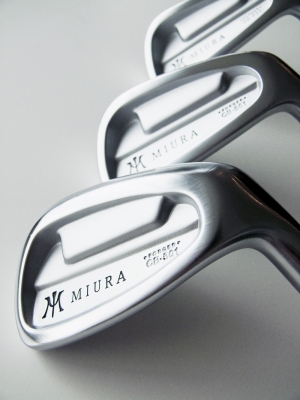 |
“From my standpoint, the only obstacle, even to playing a blade club, is whether you like the looks of it at address. If you don’t -- I’ve seen professionals and low handicappers put a blade down and say ‘I just can’t hit that’ -- and yet they’ll go out with the CB-501 and be knocking down flags all day.”
“Often it’s just a psychological thing about how you like the looks of something but not something else.”
The CB-501 irons put you in the right frame of mind from the start. As noted above, they’re beautiful to look at. The finishing on Miura irons is exquisite and there’s the confidence in knowing that one of the Miuras had his hands on every set of irons that the company makes.
All golf equipment manufacturers make worthy products, but Miura is probably at the apex when it comes to hand-crafted quality.
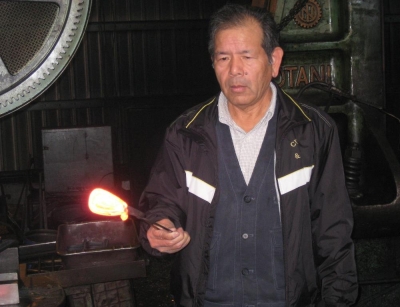 |
Playing the irons is sheer golfing pleasure. The sound is satisfying off the face and they’re buttery soft when it comes to feel. We played them using soft golf balls and sometimes it almost seemed like you’re not even striking the ball – and not just on shots hit from the sweet spot.
Forgiveness is probably the most notable element in the CB-501. Off-center hits still offered reasonable distance and the feedback from the club was sound enough to let you know it wasn’t a pure strike. That’s about all you can ask for from a golf iron.
The four and five irons were not difficult to get in the air, either.
Miura products are not inexpensive and don’t expect to find them in the bargain bin at your local golf shop. Such quality comes with a price, but you also get the knowledge that these clubs will last a long time with proper care.
It’s also great to know that a family-run business can succeed on such a personal level. According to Holowaty, even Mrs. Miura plays a role in the company.
“If you’re at the factory, odds are that at some point during the week you’ll see Mrs. Miura there – and she makes her way into the finishing room where they’re either taping off clubfaces pre-sand blast or painting the numbers and logos, etc… A number of years ago there was a shipment going out and Mrs. Miura found some imperfections.”
She took it up to her husband and said “Our name is on this, we can’t send this out.”
Needless to say, the products didn’t ship until they were perfect. Mr. Miura subsequently told Holowaty that it’s easier to do it right the first time rather than having to go home and explain why something needed to be done over again to Mrs. Miura.
That’s exactly you’ll get from Miura products – the very best, done right the first time.
Details:
Miura Golf’s North American headquarters is in Burnaby, British Columbia.
Consult the website for dealers near you, or send inquiries to Bill Holowaty, bill@miuragolf.com.
Telephone: 604-708-4653.
FAX: 604-708-4663.
Toll Free: 1-866-GO-MIURA (466-4872)
Website: www.miuragolf.com
Find a dealer: http://www.miuragolf.com/find-dealers.asp
| Related Links | Comments on this article? | |
|
Maryland National Golf Club Hollow Creek Golf Club Rocky Gap Resort PB Dye Golf Club in Ijamsville Whiskey Creek Golf Club |
E-mail Jeff Rendall, Editor: jrendall@golftheunitedstates.com |












